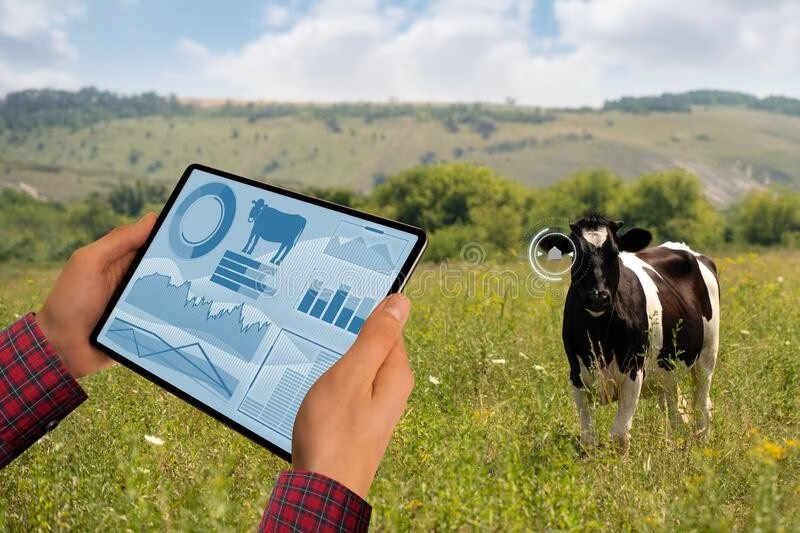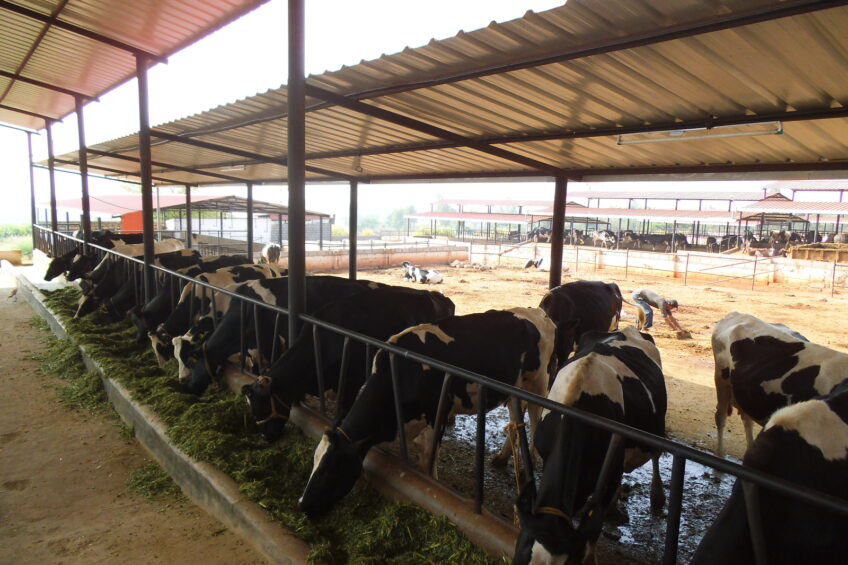Learn how data collection can change agriculture—insights on using data for better farming. Want to know how? Read on.

Data collection in dairy farming offers unmatched opportunities to boost efficiency, profitability, and sustainability. For dairy farmers, this includes:
- Monitoring herd health in real-time to address issues preemptively
- Optimizing feed based on detailed nutritional analyses
- Increasing milk production through precise breeding and genetics management
Data technology transforms agriculture, allowing dairy farmers to make more informed choices, minimize waste, and improve their operations. These improvements highlight the importance of data collecting as a critical component of dairy producers’ operational strategies. Data may help dairy farmers achieve a more productive and sustainable future, ushering in a new era of innovation in the industry.
Data Collection: The Keystone of Modern Dairy Farming
Data gathering has evolved as a critical component of efficiency and productivity in the continually changing environment of contemporary dairy production. Farmers may make educated choices that dramatically improve different aspects of their business by painstakingly collecting and evaluating many data points. Data gathering in this industry cannot be emphasized since it delivers priceless insights that drive optimization and innovation.
First and foremost, data is essential for maximizing agricultural yields. Precision agricultural methods, which rely on data analytics, allow farmers to monitor soil health, weather patterns, and crop development stages with unparalleled accuracy. This knowledge is not just beneficial, but crucial for customizing planting dates, irrigation procedures, and fertilizer inputs to each field’s demands, optimizing production and decreasing waste.
Furthermore, thorough data collection leads to better livestock management. RFID tagging and health monitoring systems give real-time information on cattle health, behavior, and productivity. This information enables farmers to quickly detect and solve health concerns, adjust feeding regimens, and boost reproductive success rates, resulting in healthier herds and increased milk output.
Data is critical for effective resource management, especially in feed. By assessing data on feed composition, consumption rates, and nutritional demands, dairy producers may develop more cost-effective feeding plans for their cattle. This not only improves the cattle’s well-being but also helps to promote sustainable agricultural techniques.
Furthermore, incorporating data into decision-making improves dairy farms’ overall strategic planning and operational efficiency. Data-driven insights help farmers make educated decisions on breeding programs and marketing strategies, minimizing uncertainty and increasing profitability. The capacity to foresee and react to trends using historical and real-time data elevates conventional farming to a sophisticated, scientifically informed operation.
The significance of data collecting in dairy farming is multidimensional, including crop yields, livestock management, resource optimization, and decision-making. As the agricultural business evolves, data will be increasingly important in driving further improvements and building a more sustainable and productive future for dairy farming.
Navigating the Legal Complexities of Data in Dairy Farming
The legal environment around data collecting in dairy farming is complex, including data ownership, privacy, and regulatory compliance concerns. At its foundation, the issue of data ownership sparks heated disputes. Who genuinely owns the data produced by sophisticated dairy farming technologies? Is it the farmer who uses the equipment and maintains the herd or the technology supplier whose software processes and saves this data?
Data ownership problems often intersect with privacy concerns. Farmers may hesitate to provide precise operational data, fearing losing a competitive edge or facing unwelcome scrutiny. Legal frameworks must address these issues by ensuring farmers maintain ownership over their data and understand how it is used and shared. Furthermore, strong privacy safeguards are required to protect sensitive data from illegal access and breaches.
Compliance with regulatory requirements is also crucial. Governments and business entities progressively enforce policies to protect data integrity and privacy. For example, compliance with data protection legislation, such as the General Data Protection Regulation (GDPR) in the European Union or the California Consumer Privacy Act (CCPA) in the United States, may be required. Dairy farms must negotiate these regulatory responsibilities, including maintaining robust data security procedures and being transparent about data use methods.
Dairy farmers and technology suppliers must agree on data ownership, consent, and use. Legal counsel may be vital in ensuring compliance and protecting stakeholders’ interests, enabling a collaborative and trust-based approach to data-driven advances in dairy farming.
Transformative Power of Data: Real-World Examples Making Impact in Agriculture
Cooperation between a significant dairy farm and a digital business specializing in agricultural software is one example of how data collecting may significantly influence agriculture. In a recent episode of The Dairy Signal Podcast, Todd Janzen of Janzen Agricultural Law LLC discussed a partnership that used a cutting-edge data analytics platform to collect data from several sensors around the farm. Sensors tracked everything from cow movement and milking practices to feed intake and barn ambient factors. The result was a comprehensive dataset that enabled farm managers to make educated choices regarding animal health and production.
In one case, the data revealed that a subset of cows had decreased activity and milk output. By cross-referencing this data with feed intake statistics, farm management discovered a nutritional imbalance in the feed given to this group. Adjusting the feed mix quickly improved the cows’ health and milk output, demonstrating the advantages of precision data collection and analysis. Janzen said, “This not only improved the welfare of the animals but also significantly enhanced the farm’s overall efficiency and profitability.”
Another intriguing example is utilizing data in crop farming to optimize water consumption. A corn farm case study created accurate irrigation maps using satellite images and soil moisture sensors. Consequently, farmers could apply water more accurately, preventing over- and under-irrigation—this data-driven method saved water—a valuable resource in many agricultural areas—while increasing crop yields. Janzen presented a particular example in which altering irrigation schedules based on real-time data resulted in a production gain of more than 15%, highlighting how technology can promote sustainable agricultural practices.
These examples demonstrate the revolutionary power of data collecting in agriculture, supporting Todd Janzen’s call to integrate sophisticated data solutions into agricultural operations. By harnessing data, farms may improve operational efficiency, improve animal welfare, and contribute to sustainable agricultural practices that benefit both the producer and the environment.
Overcoming the Challenges in Data-Driven Dairy Farming
Although transformational, collecting and using data in dairy production has several obstacles. One of the most significant issues farmers face is integrating several data sources. Data from sensors, equipment, and manual entry may not be easy to organize into a coherent and usable structure. Furthermore, farmers often need help comprehending and interpreting data, which may impede decision-making.
Data security is yet another big challenge. Digitalizing agricultural techniques exposes them to cyber dangers, data breaches, and unwanted access. Ensuring the security and integrity of this vital information is critical to preserving trust and operational effectiveness. Data privacy problems occur, especially when data is shared with third-party service providers or via cloud-based systems.
Addressing these difficulties demands a multifaceted strategy. To begin with, investing in user-friendly data management solutions may help speed up the integration of several data sources, making them more accessible and interpretable. Training programs and seminars may help farmers overcome the knowledge gap and exploit data more effectively.
Farmers should use strong cybersecurity measures to protect their data, such as encryption, access limits, and frequent security audits. Partnering with reliable service providers that follow industry norms and laws may help to protect data. Implementing a clear data governance strategy that defines data-sharing methods and privacy standards is also critical for ensuring data integrity.
While the problems in data gathering and usage are significant, they are manageable. Farmers may overcome these challenges by strategically investing in technology, education, and security and using data to promote innovation and efficiency in dairy production.
Future Technologies in Dairy Farming: AI, ML, and IoT
Looking forward, it’s clear that agricultural data collecting is on the verge of another transformational shift. Integrating Artificial Intelligence (AI) with Machine Learning (ML) is one of the developing concepts. These technologies promise to gather data more effectively and analyze it in ways that will enable predictive analytics. For example, AI can assist in anticipating weather patterns and agricultural yields and even identify early symptoms of illness in animals, providing farmers with actionable information before problems arise.
Another emerging trend is the widespread deployment of IoT (Internet of Things) devices on farms. These gadgets can monitor anything from soil moisture levels to animal health in real-time and send the information to centralized computers for complete analysis. Gathering such detailed, real-time data might lead to unparalleled accuracy in agricultural operations, optimizing inputs like water, fertilizers, and labor to optimize output while reducing waste.
Todd Janzen sees these achievements as critical to determining the future of farming. He believes that integrating massive volumes of data via interoperable technologies will become the standard, enabling farmers to make educated choices based on data from numerous sources. Janzen thinks a single data ecosystem in agriculture would improve cooperation between farmers and technology providers, allowing hitherto unthinkable breakthroughs. Furthermore, he predicts these technologies will increase agricultural productivity and sustainability, allowing for improved resource management and minimizing farming operations’ environmental imprint.
The trend of agricultural data collecting is shifting toward more connected, intelligent, and usable systems. The convergence of AI, ML, and IoT technologies is poised to transform data collection and use, opening the way for a more prosperous, efficient, and sustainable agricultural environment.
The Bottom Line
Data-driven approaches are essential for contemporary dairy production since they improve efficiency, health management, and profitability. Precise data allows operation optimization and the management of difficulties such as virus outbreaks, as well as maintaining herd health and financial stability. This essay investigates the role of data, legal complexity, real-world implications, and emerging technologies such as AI, ML, and IoT that are set to change the sector. Understanding legal issues is critical for embracing technology. Integrating these factors may improve productivity and sustainability. Use data responsibly. Equip yourself with the expertise to navigate the digital world, ensuring that your farm is at the forefront of innovation, increasing efficiency and profitability, and contributing to the transformation of agriculture.
Key Takeaways:
- Modern dairy farming heavily relies on data collection to optimize productivity and animal welfare.
- Legal complexities surrounding data ownership and usage are significant, necessitating careful navigation and informed decision-making.
- Real-world examples highlight the transformative power of data in agriculture, demonstrating tangible improvements in efficiency and sustainability.
- Data-driven dairy farming presents challenges such as data security, interoperability of systems, and the need for robust data management strategies.
- The future of dairy farming is poised to benefit from advancements in AI, machine learning, and IoT, promising further enhancements in productivity and animal health.
Summary:
Dairy farming is a complex industry that requires a balance of tradition and modernity. Advanced data-collecting techniques enable farmers to optimize farm areas using data-driven insights, boosting efficiency, profitability, and sustainability. This includes real-time monitoring of herd health, optimizing feed based on nutritional analyses, and increasing milk production through precise breeding and genetics management. Data technology transforms agriculture, allowing farmers to make informed choices, minimize waste, and improve operations. Precision agricultural methods allow farmers to monitor soil health, weather patterns, and crop development stages with unparalleled accuracy, which is crucial for customizing planting dates, irrigation procedures, and fertilizer inputs. Real-time information on cattle health, behavior, and productivity enables farmers to quickly detect health concerns, adjust feeding regimens, and boost reproductive success rates, resulting in healthier herds and increased milk output. Data is critical for effective resource management, especially in feed, and incorporating it into decision-making improves dairy farms’ strategic planning and operational efficiency. Future technologies in dairy farming include AI, ML, and IoT, which promise to gather and analyze data more effectively, enabling farmers to make educated choices based on multiple sources.












